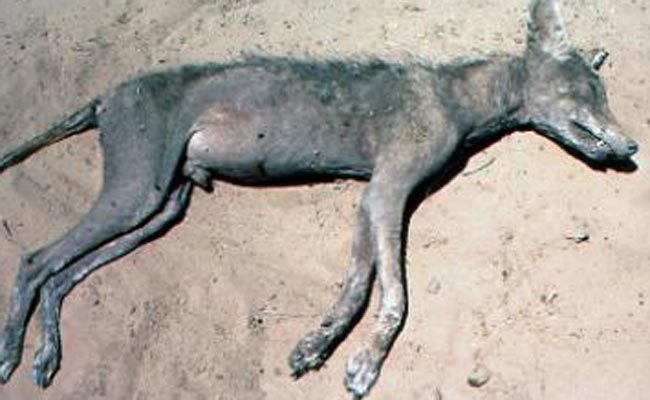Chupacabra: Facts about the Mysterious Vampire Beast
The chupacabra was a very recent addition to the Mysterious Monster Club, coming many decades after Bigfoot and the Loch Ness monster made their debuts. But only a few years after the chupacabra first appeared on the scene, the mystery was solved.
Bigfoot, the mysterious beast said to roam the North American wilderness, is named after what it leaves behind: big footprints. Bigfoot's Hispanic cousin, the chupacabra, is also named for what it leaves behind: dead animals. Though goats are said to be its favorite prey (chupacabra means "goat sucker" in Spanish), it has have also been blamed for attacks on cats, rabbits, dogs, chickens, and other animals.
There are no known photographs of the beast, or even credible footprints. Instead, the chupacabra is known mostly through a few dozen eyewitness sightings and many dead animals. The chupacabra is probably the world's best-known vampire after Dracula, and its victims are often claimed to have been found completely drained of blood.
[Famous Fangs: Tales of Our Favorite Vampires]
Descriptions of chupacabra vary widely, but many accounts suggest that the creature stands about four to five feet tall. It has powerful legs that allow it to leap huge distances, long claws, terrifying, glowing red eyes, and distinctive spikes down its back. While some believe that chupacabra sightings date back to the 1970s or earlier, the monsteractually first appeared in 1995 in Puerto Rico; there are no records of any vampiric chupacabras before that time.
Theories about the chupacabra's origin are as varied as the sightings themselves. The most popular explanation is that it is the product of top-secret U.S. government genetics experiments in the rainforest of Puerto Rico. Some suggest that it's an extraterrestrial being, brought to Earth on spaceships. Still others suggest that the mysterious creature is part of some sinister biological warfare program, or even the embodiment of God's wrath.
Types of chupacabras
Get the world’s most fascinating discoveries delivered straight to your inbox.
The chupacabra had a heyday of about five years when it was widely reported in Puerto Rico, Mexico, Chile, Nicaragua, Argentina, and Florida, among other places—almost all of them in Spanish-speaking areas. After about 2000, a strange thing happened: sightings of the weird, alien, bipedal, spiky-backed chupacabra faded away. Instead, the Hispanic vampire took a very different form: a canine animalresembling hairless dogs or coyotes mostly found in Texas and the American Southwest.
[Rumor or Reality: The Creatures of Cryptozoology]
This was an important turning point because — unlike Bigfoot, the Loch Ness monster, for example — suddenly researchers had animal carcasses to scientifically examine. Dead chupacabras were subjected to DNA tests and in every instance the body has been identified as a dog, coyote, raccoon, or other common mammal — usually stricken with a parasitic infection that caused the animal to lose its fur and take on a gaunt, monstrous appearance.
Geneticists and wildlife biologists have identified all of the alleged chupacabra carcasses as those of known animals. But if none of the animals were vampiric chupacabras, what was sucking the blood out of goats, chickens, and other livestock? Though dead animals were widely reported to have been drained of blood, this is a myth. When suspected chupacabra victims have been professionally autopsied, invariably they are revealed to contain plenty of blood.
So what attacked the animals, if not the dreaded chupacabra? Sometimes the simplest answer is the correct one: ordinary animals, mostly dogs and coyotes. These animals instinctually go for a victim's neck, and their canine teeth leave puncture wounds that resemble vampire bite marks. Though many people assume that dogs and coyotes would eat or tear up the animals they attack, wildlife predation experts know this too is a myth; often they will simply bite the neck and leave it to die.
Chupacabra: Mystery solved
Though the canine chupacabras were identified, the question remained: what happened to the original chupacabra? Why did it suddenly appear in August 1995 and vanish after only a few short years? As reported in the book "Tracking the Chupacabra: The Vampire Beast in Fact, Fiction, and Folklore," (University of New Mexico Press, 2011), it turned out that the chupacabra could be traced back to a single original eyewitness, a Puerto Rican woman named Madelyne Tolentino, whose sighting became the basis for all other accounts of the creature. She offered a detailed description of the chupacabra (bipedal, dark eyes, long limbs, and spikes along its back) that did not match any known animal — if it was real.
[Bigfoot, Nessie & the Kraken: Cryptozoology Quiz]
However, Tolentino's chupacabra was nearly identical to an alien monster in the science fiction / horror film "Species." The similarities were too great to be coincidence; she had not only recently seen the film, but stated in interviews that the movie monster "looked like the chupacabra, with spines on its back and all. ... The resemblance to the chupacabra was really impressive."
She was the first person to report seeing the chupacabra, and her report was very influential, appearing not only on the front page of the local newspaper but all over the Internet. Soon other eyewitnesses repeated and exaggerated her description, but it is clear that what she described came from a movie, not real life.
Though there's little mystery left from a scientific point of view, the goat-sucking monster will continue to be reported whether the creatures exist or not, simply because the public has come to call any strange unknown animal a "chupacabra."
Benjamin Radford is deputy editor of "Skeptical Inquirer" science magazine and author of six books, including "Scientific Paranormal Investigation: How to Solve Unexplained Mysteries." His website is www.BenjaminRadford.com.




